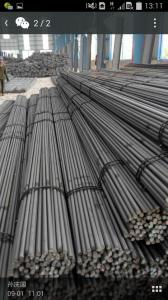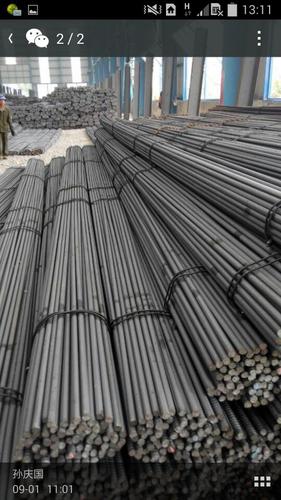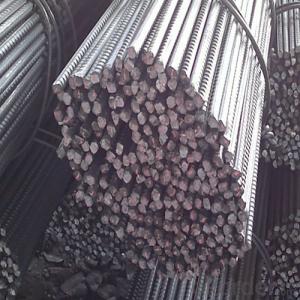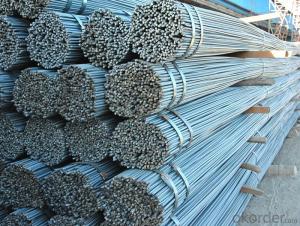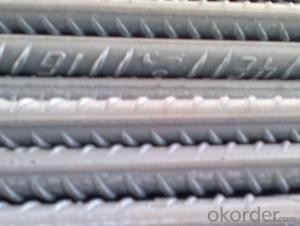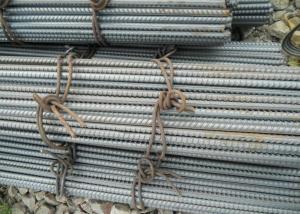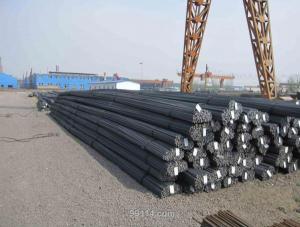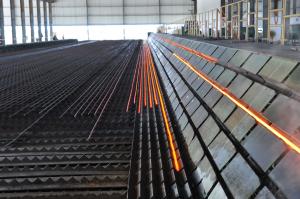Hot Rolled Deformed Bar D-BAR HRB400 HRB500 B500B B500C
- Loading Port:
- Tianjin
- Payment Terms:
- TT or LC
- Min Order Qty:
- 25 m.t.
- Supply Capability:
- 40000 m.t./month
OKorder Service Pledge
OKorder Financial Service
You Might Also Like
Product Description:
OKorder is offering Hot Rolled Deformed Bar D-BAR HRB400 HRB500 B500B B500C at great prices with worldwide shipping. Our supplier is a world-class manufacturer of steel, with our products utilized the world over. OKorder annually supplies products to European, North American and Asian markets. We provide quotations within 24 hours of receiving an inquiry and guarantee competitive prices.
Product Applications:
Hot Rolled Deformed Bar D-BAR HRB400 HRB500 B500B B500C are ideal for structural applications and are widely used in the construction of buildings and bridges, and the manufacturing, petrochemical, and transportation industries.
Product Advantages:
OKorder's Hot Rolled Deformed Bar D-BAR HRB400 HRB500 B500B B500C are durable, strong, and resist corrosion.
Main Product Features:
· Premium quality
· Prompt delivery & seaworthy packing (30 days after receiving deposit)
· Corrosion resistance
· Can be recycled and reused
· Mill test certification
· Professional Service
· Competitive pricing
Product Specifications:
Standard | GB | HRB400 | |
Diameter | 6mm,8mm,10mm,12mm,14mm,16mm,18mm,20mm, 22mm,25mm,28mm,32mm,36mm,40mm,50mm | ||
Length | 6M, 9M,12M or as required | ||
Place of origin | Hebei, China mainland | ||
Advantages | exact size, regular package, chemical and mechanical properties are stable. | ||
Type | Hot rolled deformed steel bar | ||
Brand name | DRAGON | ||
Usage and Applications of HRB400 Deformed Steel Bar:
Deformed bar is widely used in buildings, bridges, roads and other engineering construction. Big to highways, railways, bridges, culverts, tunnels, public facilities such as flood control, dam, small to housing construction, beam, column, wall and the foundation of the plate, deformed bar is an integral structure material. With the development of world economy and the vigorous development of infrastructure construction, real estate, the demand for deformed bar will be larger and larger..
Packaging & Delivery of HRB400 Deformed Steel Bar:
Packaging Detail: products are packed in bundle and then shipped by container or bulk vessel, deformed bar is usually naked strapping delivery, when storing, please pay attention to moisture proof. The performance of rust will produce adverse effect.
Each bundle weight: 2-3MT, or as required
Payment term: TT or L/C
Delivery Detail: within 45 days after received advanced payment or LC.
Label: to be specified by customer, generally, each bundle has 1-2 labels
Trade terms: FOB, CFR, CIF
FAQ:
Q1: Why buy Materials & Equipment from OKorder.com?
A1: All products offered byOKorder.com are carefully selected from China's most reliable manufacturing enterprises. Through its ISO certifications, OKorder.com adheres to the highest standards and a commitment to supply chain safety and customer satisfaction.
Q2: How do we guarantee the quality of our products?
A2: We have established an advanced quality management system which conducts strict quality tests at every step, from raw materials to the final product. At the same time, we provide extensive follow-up service assurances as required.
Q3: How soon can we receive the product after purchase?
A3: Within three days of placing an order, we will begin production. The specific shipping date is dependent upon international and government factors, but is typically 7 to 10 workdays.
Q4: What makes stainless steel stainless?
A4: Stainless steel must contain at least 10.5 % chromium. It is this element that reacts with the oxygen in the air to form a complex chrome-oxide surface layer that is invisible but strong enough to prevent further oxygen from "staining" (rusting) the surface. Higher levels of chromium and the addition of other alloying elements such as nickel and molybdenum enhance this surface layer and improve the corrosion resistance of the stainless material.
Q5: Can stainless steel rust?
A5: Stainless does not "rust" as you think of regular steel rusting with a red oxide on the surface that flakes off. If you see red rust it is probably due to some iron particles that have contaminated the surface of the stainless steel and it is these iron particles that are rusting. Look at the source of the rusting and see if you can remove it from the surface.
Images:
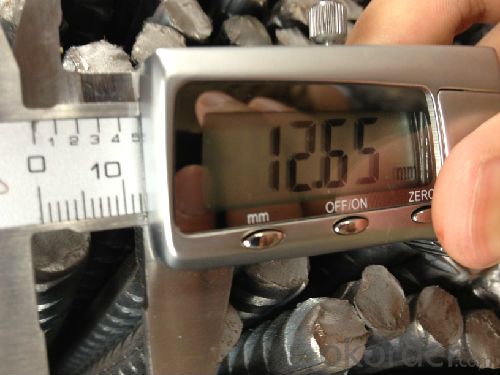
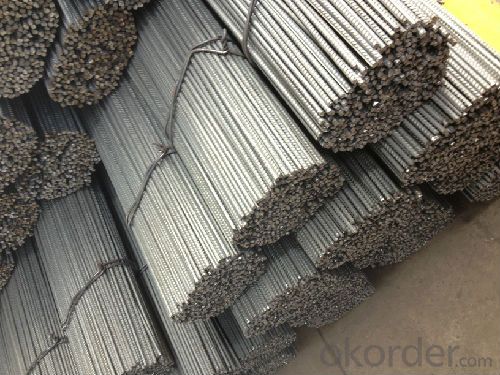
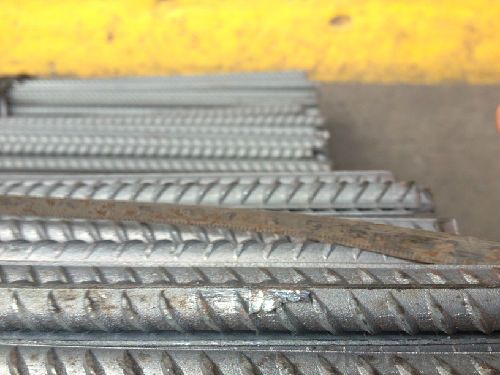
- Q: What are the best practices for handling and storing steel rebars on a construction site?
- Some best practices for handling and storing steel rebars on a construction site include: 1. Properly stacking and bundling rebars to prevent accidents and injuries. Ensure that they are stored in a well-organized manner to minimize the risk of collapsing stacks. 2. Use appropriate lifting equipment, such as cranes or forklifts, to handle and move rebars safely. Avoid dragging or rolling them on the ground, as this can cause damage and compromise their structural integrity. 3. Protect rebars from exposure to moisture, excessive heat, and corrosive substances. Store them in a dry and covered area to prevent rusting and degradation. 4. Label rebars with relevant information, such as size, type, and grade, to ensure proper identification and usage. This helps in maintaining accurate inventory and preventing mix-ups during construction. 5. Regularly inspect rebars for any signs of damage, such as bends, cracks, or excessive rust. Damaged rebars should be removed from the site and replaced to maintain structural integrity. 6. Train construction workers on safe handling and storage practices for rebars, emphasizing the importance of following guidelines and using appropriate personal protective equipment (PPE). By adhering to these best practices, construction sites can ensure the safety and integrity of steel rebars, contributing to the overall success of the project.
- Q: How do steel rebars contribute to the overall sustainability of a construction project?
- Steel rebars contribute to the overall sustainability of a construction project in several ways. Firstly, they enhance the structural integrity and durability of concrete structures, reducing the need for frequent repairs or replacements, thus minimizing material waste and conserving resources. Additionally, steel rebars can be recycled at the end of their life cycle, reducing the demand for new raw materials and decreasing the carbon footprint of the project. Furthermore, their high tensile strength allows for the construction of lighter and more efficient structures, reducing the overall energy consumption during the project's lifespan. Overall, steel rebars play a crucial role in promoting the sustainability of construction projects by ensuring longevity, recyclability, and improved energy efficiency.
- Q: What are the different corrosion protection methods for steel rebars?
- Steel rebars commonly used in reinforced concrete structures have various corrosion protection methods available. These methods aim to prevent or minimize rebars' corrosion, which can significantly weaken the overall structure. 1. Concrete Cover: An effective corrosion protection method involves providing a sufficient thickness of concrete cover over the rebars. This creates a physical barrier, preventing the rebars from being exposed to corrosive elements. 2. Galvanization: Another method is to coat the rebars with zinc through a process called galvanization. This protective layer acts as a sacrificial anode, corroding before the rebars and enhancing their resistance to corrosion. 3. Epoxy Coating: A popular approach is applying a layer of epoxy resin over the rebars. This coating acts as a barrier, preventing moisture and corrosive substances from reaching the rebars. 4. Cathodic Protection: An electrochemical method known as cathodic protection involves using a sacrificial anode or an impressed current system. In a sacrificial anode system, a more reactive metal like zinc or magnesium is connected to the rebars, sacrificing itself to prevent corrosion. In an impressed current system, an external power source supplies a protective current to the rebars, preventing corrosion. 5. Corrosion Inhibitors: Chemicals can be added to the concrete mix or applied as a surface treatment to act as corrosion inhibitors. These substances create a protective film on the rebars' surface, blocking corrosive agents' access and preventing corrosion. 6. Stainless Steel Rebars: An effective method is to use stainless steel rebars, which have high resistance to corrosion. This makes them suitable for structures exposed to aggressive environments. It is important to consider various factors, such as environmental conditions, expected service life, and cost, when selecting the appropriate corrosion protection method. Regular inspection and maintenance of the system are also necessary to ensure its long-term effectiveness.
- Q: What are the different types of steel rebars used in high-rise buildings?
- High-rise buildings commonly utilize various types of steel rebars due to their strength and durability. These include: 1. Mild Steel Rebars, also known as black bars, are frequently used in construction. They possess a low carbon content and are easily weldable, making them ideal for reinforcing concrete structures. 2. High Strength Deformed (HSD) Steel Rebars have a higher tensile strength than mild steel rebars. They are created through cold twisting or stretching of mild steel bars, resulting in a deformed pattern on the surface that enhances bonding with concrete. 3. Corrosion-Resistant Steel Rebars are utilized in high-rise buildings located in coastal areas or regions with high humidity. They are coated with epoxy or galvanized to protect against moisture and corrosive elements, preventing rust and deterioration. 4. Carbon Steel Rebars, made of carbon steel, have a higher carbon content compared to mild steel rebars. They offer excellent tensile strength and are often employed in high-rise buildings that require additional reinforcement. 5. Stainless Steel Rebars are highly resistant to corrosion and can endure extreme weather conditions. They are commonly used in high-rise buildings that necessitate long-term durability and protection against rust. 6. TMT (Thermo-Mechanically Treated) Steel Rebars are manufactured by subjecting mild steel bars to a combination of heat treatment and mechanical deformation. This process imparts superior strength and ductility to the rebars, making them suitable for high-rise buildings where seismic resistance is crucial. Each type of steel rebar possesses distinct properties and advantages, enabling engineers and construction professionals to select the most suitable type based on the requirements and specifications of the high-rise building project.
- Q: Can steel rebars be used in the construction of stadiums for indoor sports?
- Yes, steel rebars can be used in the construction of stadiums for indoor sports. Steel rebars are commonly used in the construction industry to provide reinforcement and strength to concrete structures. In the case of stadiums, steel rebars can be used to reinforce the concrete columns, beams, and slabs that make up the foundation, walls, and floors of the indoor sports facility. This ensures the structural integrity and durability of the stadium, making it capable of withstanding heavy loads and providing a safe environment for athletes and spectators.
- Q: How do steel rebars affect the overall acoustics of a building?
- Steel rebars do not have a significant impact on the overall acoustics of a building. The primary purpose of rebars is to reinforce concrete structures, providing strength and stability. Acoustic properties are mainly influenced by factors such as building materials, design, and insulation, rather than the presence of steel rebars.
- Q: What is the composition of steel rebars?
- Steel rebars are primarily composed of carbon, manganese, and small amounts of other elements such as sulfur and phosphorus. The main component, carbon, gives steel rebars their strength and durability, while manganese helps improve their overall toughness and workability.
- Q: What are the guidelines for proper tying of steel rebars in concrete structures?
- To ensure the structural integrity and durability of concrete structures, it is crucial to adhere to guidelines for the proper tying of steel rebars. Here are some important guidelines to consider: 1. Rebar Placement: Before tying, accurately position the rebars according to the structural drawings and design specifications. Place them at the designated locations and depths, ensuring proper spacing to provide the necessary strength and reinforcement. 2. Tying Tools: Utilize suitable tools like pliers or rebar tying machines for secure and proper tying. Ensure that the tools are in good condition and appropriate for the size and type of rebars being used. 3. Tying Technique: Employ a consistent and efficient tying technique. Begin by securely holding the rebars together at the intersection point. Wrap the tie wire around both rebars multiple times, ensuring tight and firm connections. Properly twist and neatly cut the tie wire to avoid any protrusions. 4. Tie Wire Selection: Use high-quality tie wires with sufficient strength to withstand tension and load requirements. Opt for corrosion-resistant materials such as galvanized steel or stainless steel to prevent rusting and deterioration over time. 5. Tying Spacing: Adhere to the specified tying spacing as per the design requirements. Adequate spacing between ties helps maintain rebars in their designated positions, preventing displacement during concrete pouring and subsequent curing. 6. Tying Quantity: Tie rebars at suitable intervals to ensure ample connection and reinforcement. The number of ties needed depends on the size, shape, length of rebars, and structural design specifications. 7. Tying Consistency: Maintain consistency in tying throughout the entire concrete structure. Uneven or inconsistent tying can result in weak points, reduced reinforcement, and compromised structural integrity. 8. Tying Safety: Prioritize safety during the tying process. Wear appropriate personal protective equipment (PPE) like gloves and safety glasses to prevent injuries. Take precautions to avoid tripping hazards and ensure a safe working environment. 9. Inspection and Quality Control: Regularly inspect the tied rebars to ensure compliance with design specifications and quality standards. Conduct visual inspections and perform pull tests to assess the strength and effectiveness of the ties. 10. Compliance with Codes and Standards: Adhere to local building codes, industry standards, and engineering guidelines specific to your region. These codes provide essential requirements for rebar tying, ensuring the durability and safety of the concrete structure. By following these guidelines, construction professionals can enhance the strength, stability, and longevity of concrete structures through proper tying of steel rebars.
- Q: Can steel rebars be used in road construction?
- Yes, steel rebars can be used in road construction. Steel rebars are commonly used as reinforcement in concrete structures, including roads and highways, to enhance their strength and durability. They provide additional support to withstand heavy traffic loads and prevent cracking or deformation of the road surface.
- Q: What is the difference between drawing steel and round steel on drawing?
- Said method of thread steel: a circle and a vertical line and a horizontal line is a steel, is two steel, and then a circle and a vertical line and two line is the steel line below, but the level of a level, is grade three steel.
Send your message to us
Hot Rolled Deformed Bar D-BAR HRB400 HRB500 B500B B500C
- Loading Port:
- Tianjin
- Payment Terms:
- TT or LC
- Min Order Qty:
- 25 m.t.
- Supply Capability:
- 40000 m.t./month
OKorder Service Pledge
OKorder Financial Service
Similar products
Hot products
Hot Searches
Related keywords
